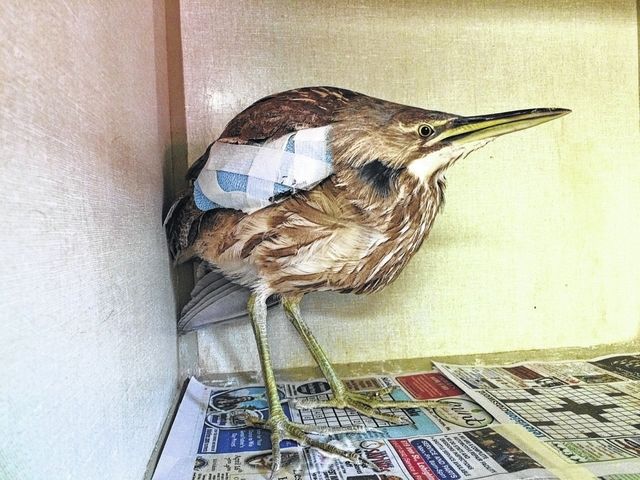Click here to subscribe today or Login.
Davidson Township, Sullivan County – as the American bittern manuervered through the tall grass toward the open water of Splash Dam Pond, it didn’t look like a dangerous bird.
The bittern, which is on the state endangered species list, was released by the Pennsylvania Game Commission on Monday after spending the last month and a half at the Carbon County Environmental Education Center recovering from a broken wing.
While at the center, the staff took a few safety precautions while caring for the fish eating bird. They wore goggles anytime they fed or handled it, and always removed any jewelry that the bittern could grab.
Why?
The bittern uses it’s dagger-like bill to catch its prey – mainly fish or amphibians, and the staff and the CCEEC didn’t want to tempt the bird into taking a stab at dangling jewelry or an eye.
But at the release site on State Game Lands 13, safety wasn’t an issue. Pennsylvania Game Commission biologist Kevin Wenner and information and education specialist Bill Williams hauled the bittern in a box down to Splash Dam Pond, opened the lid and let the bird set foot on its new home.
“This is a tremendous day,” Williams said. “It’s very rare to see an American bittern in northeastern Pennsylvania, and here we have the opportunity to release one into the wild.”
The bittern was discovered in Bloomsburg in March, near the fairgrounds, and it was unable to fly. The bird was taken to the CCEEC with the hope it could be saved.
Sue Gallagher, a wildlife rehabilitator with the CCEEC, said the outlook for the bittern was optimistic at the start.
The wing was fractured at the tip, she said, which is a place that generally heals better.
“The closer the fracture is to the bird’s body, the less chance it will fly again,” Gallagher said. “This bird was very lucky the fracture was very far out from the body.”
Gallagher said when the bittern was brought to the center it was also scuffed up, leading her to suspect it was hit by a car. As the wing healed staff at the CCEEC went about the arduous task of feeding the bittern daily. With goggles on and jewelry removed, Gallgher fed the bittern a commercial powdered fish formula via a tube inserted in the bittern’s bill.
To replicate the bird’s natural diet, live fish were introduced but Gallagher said it wasn’t interested at first.
“We fed it dead fish for a while and then tried live fish again. We put the fish in a big, plastic tub and eventually he began stalking them just like he would in the wild,” Gallagher said. “There’s almost something prehistoric about it when you see that.”
After a bit of time in the flight pen, the bittern was ready to leave the center and get back to the wild. Game Commission staff originally selected Bowman’s Marsh as the release site, but Doug Gross, supervisor of the agency’s endangered and non-game bird section, said there was another make bittern in that area and recommended against releasing another one there.
Splash Dam Pond was chosen as an alternate site because it had everything a bittern needs, Gross said.
“This has wetlands and tall grass surrounding open water, which is very suitable,” Gross said. “Bitterns prefer the tall grass around water to forage and camouflage themselves.”
After the bittern was released from the box, it waddled into the tall grass. It’s streaky coloration blended in with the swaying grass, and the bittern slowly walked toward the water in an upright postition with it’s beak straight up – a posture it takes when it feels threatened.
Gross said he has confirmed bitterns nesting at Splash Dam Pond in the 1990s and the latest release gave him hope it could happen again. Statewide, he said, bittern numbers have greatly decreased. There are less than 10 locations in the state where they are known to exist, Gross said, estimating there are 20 pairs total.
“Their decline is attributable to the decrease of wetland habitat,” Gross said. “As suitable wetlands become harder to find, bitterns become isolated and that imapcts reproduction.”
For Gallagher, the bittern was the third one she has rehabilitated. In fact, an American bittern was one of the first birds brought to the center almost 30 years ago. A second bittern came in two years ago and both were successfully rehabilitated and released.
“I’m always happy to see them go and I’m happy this one garnered so much attention,” Gallagher said. “Perhaps this will alert people why the bittern is critically endangered and it shows that our wetland habitats are important for reasons such as this.”







